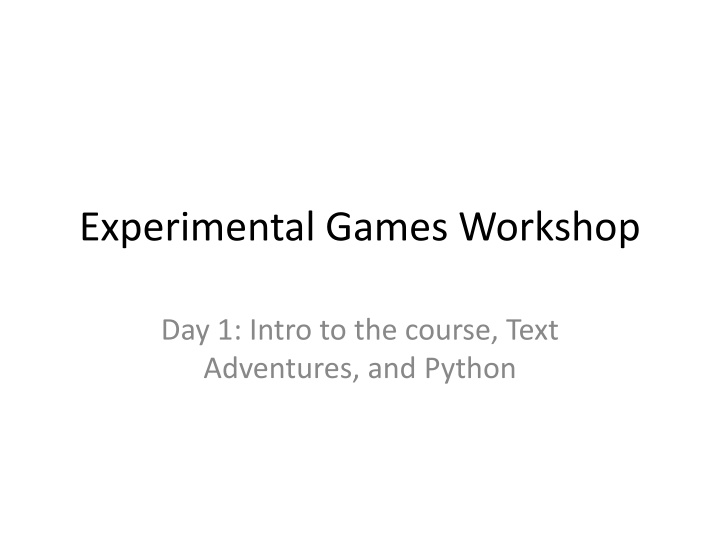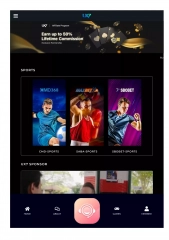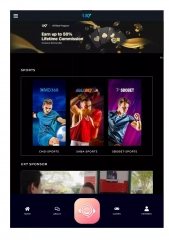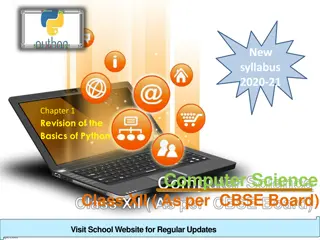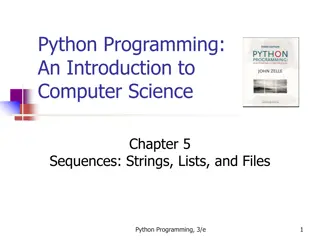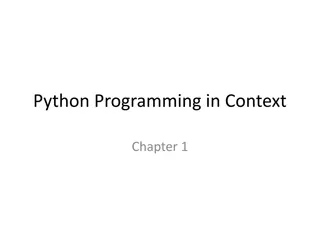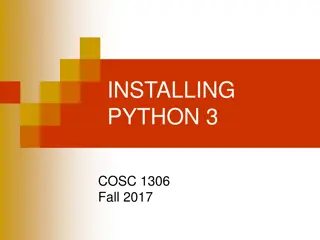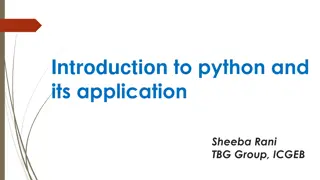Experimental Games Workshop: Intro to Text Adventures & Python
Welcome to the Experimental Games Workshop Day 1! Join us for an introductory course exploring Python for text adventure games and other exciting topics like game design, microcontrollers, and more. Collaborate with peers, engage in teamwork, and dive into experimental game development. Get ready for a fun and experimental learning experience where both the teacher and students contribute to creating innovative game projects together.
Download Presentation

Please find below an Image/Link to download the presentation.
The content on the website is provided AS IS for your information and personal use only. It may not be sold, licensed, or shared on other websites without obtaining consent from the author.If you encounter any issues during the download, it is possible that the publisher has removed the file from their server.
You are allowed to download the files provided on this website for personal or commercial use, subject to the condition that they are used lawfully. All files are the property of their respective owners.
The content on the website is provided AS IS for your information and personal use only. It may not be sold, licensed, or shared on other websites without obtaining consent from the author.
E N D
Presentation Transcript
Experimental Games Workshop Day 1: Intro to the course, Text Adventures, and Python
Welcome! I am so excited to be doing this Directed Study with you this term. If you have not done a Directed Study before, in a nutshell it is a chance for students and teachers to work collaboratively to explore a chosen range of topics. In our case, we are looking to explore the proposed topics for the 2021 Advanced Game Design course: An introduction to Python for implementing Text Adventure games Creating Custom Controller games with Microcontrollers and Unity Creating Multi-Device games in Unity with various networking tools The teacher will present a lot of this material, and a lot will be presented by participating students, either through previous knowledge and experience or research done this term. Both our games and our approach are experimental! We are creating this course together. If there is something you would suggest we be doing differently this term, please speak up! Let s have some fun!
Teamwork and Other Responsibilities All of you have taken the prerequisite for this course, COMP50/COMP23 Game Design. Some of the ways we ran that course would be useful here: Games are designed by students in teams. Good working relationships are as much the goal of this course as the game products. Listen to each other, and solicit input! Team-members are mindful to positively contribute to both production and morale: we expect tangible weekly contributions to games and daily communication (even a brief hello to check-in and make sure we are not blocking anyone). Peer evaluation is used to help support accountability. Typed progress reports for the teacher, to document personal progress Attend at least one local industry networking event (PAX East counts) For this Directed Study there are no separate TAs; you are the TAs! Help each other solve problems by offering guidance, pointing to resources, or switching production roles. Also, do we need expertise not present in this group? Let s discuss bringing in a guest lecturer. Sam Guyer is excited to show us his cool experiments with micro- controlled interactive lighting!
Some Initial Course Questions Project #1: Text Adventures can be created collaboratively or solo. It can be a LOT of fun to write with peers, or you may have a singular vision you want to explore. Which do you prefer for this project? Project #2: Brandon Stafford <brandon.stafford@tufts.edu> runs the Nolop Makerspace, and has offered to make microcontroller purchases on our behalf (whole sale electronics in bulk, so our cost would be minimal, and the teacher has a modest budget). These purchases can take multiple weeks to deliver. To get them by week 5 (when we are done with our text adventures and initial micro-controller experiments in Makey-Makey), we need to ask for them this week. What do we want? Project #3: Do we need any testing hardware that we do not currently possess? For example, if we want to do a multi-device mobile game, do we have the phones or tablets needed to develop and text the game.
Writing for Games 1: What do Game Writers do? Game Writers wear many hats (learn more by watching the interviews and talks on the course site!) Branching Narrative Event-driven character language (like kill-lines in a fighting game) Descriptions Dialogue Environmental design as world-building, often designed by writing Also non-verbal character cues and events, etc.: the overall story. Let s try it a bit ourselves: Game Writing Prompt #1
Writing for Games 2: How is a game narrative different than other forms of narrative? What do they have in common?
Writing for Games 2: How is a game narrative different than other forms of narrative? What do they have in common? Game Narrative Uniquely Requires: Choice-rich story design Player-focused: Character, Conflict, Desire, Setting But it can be similar to traditional, linear narrative in having: 3-Act structure (which does not need to be followed: we can do the simpler character enters a place wanting something, finds it, either gets it or not) Short Form Narratives: Brainstorming and starting from situations the player finds themselves, the narrative already well underway, not beginnings.
Writing for Games 2: How is a game narrative different? Text Adventures: Types: multiple-choice (choice-script) vs exploration (parser) Images, sounds, or no multimedia Created as long or short form, low barrier to entry, used for personal or revolutionary stories. Recommendation: Avoid easy death: we do not need to write lady or the tiger scenarios they do not need to be just binary experiences. We can track bravery and creativity and other elements in player choices, and create experiences that respond to those choices. Before we code, generate ideas on notecards! We should also play some games: like a Choice game (Choice of the Dragon) or a Parser game (Lost Pig)
Is every choice a good choice? 1. Build your story on Meaningful Choice: Player choice must not be just cosmetic: it should determine the course of their game experience. While it is true game narratives tend to branch and then taper to common gate experiences in order to manage development resources and maintain some continuity in experience, players need to know that their choices are what defines their opportunities and determines their outcomes. Consider open worlds where the player can do anything, but their actions cause certain stats to be adjusted, changing the ways in which groups of NPCs react to them and offer opportunities. Or consider failure-rich environments like the classic Choose-Your- Own-Adventure game books, where most paths ended in player death and an early end to the story, and the challenge was to find the longest path to read the most and end more happily.
Is every choice a good choice? 2. Strive For Weird: Consider weird characters whose strangeness can inform player choices and abilities. Consider weird situations that can presents regular human concerns and conflicts in extra high contrast by separating them from ordinary life, thus offering a distilled, deeper understanding. This is the common power of Science Fiction and Fantasy: to create a metaphor for human experience. 3. Character is revealed through society: While inward-focused stories about solitude and survival can work, most players are interested in connecting with others, and character is revealed in choices made out in the world. Consider the player choices and emotional experiences defined by the companions in Ico, Portal, Dad of War, and the Walking Dead.
Game Narrative: Scope NOTES ON STRUCTURE/SCOPE: Game Narrative is typically planned out and represented as a tree of choices. TREE format: To limit overall branching for reasonable scope, and to allow for the narrative to follow a more traditional story structure, most text adventures have pinch points, where the narrative choices cut down to the same event. If this is done twice, we can get a rough 3-act structure. WEB format: Alternatively, consider a physical space with multiple rooms, like a mansion. Each room represents a choice: where will the player go next? What will they find in each? To make the rooms remember our presence, track our interactions in each. Story events can then occur when certain elements are found and put together, or after a certain number of rooms have been entered. SCOPE: To create a limited-choice game, only 2/3 of passages offer choices, and all of which return to 2-4 branches. Project Length guidelines: A single read would be about 1 page/minute, or 5 passages (screens)/minute. We will do a short 5-minute story; with branching narrative kept limited, assume 10 pages (50 passages) for the full story.
Game Narrative: Pinch Points By bringing the narrative back to these bottlenecks/ pinch-points, we not only save on project scope; we can create emotional beats that every player gets to experience. The experience of these pinch points does not need to be completely identical; as one big event happens that everyone experiences, different paths can lead to different perspectives on that event (so the lines would meet at 2 or three nodes, rather than one). EXAMPLE 2: An earthquake hits the city at the pinch point: did the player s choices lead them to be above ground, helping the rescue efforts, or in a building that collapsed, and they are struggling to survive long enough to be rescued? EXAMPLE 1: A storm hits the ship at the pinch point: did the player s choices lead them to be on deck when that happens, struggling with sails, or below decks, dealing with the water that is entering the hold?
Game Narrative: Flowcharts Branches and Bottlenecks Flow outwards and inwards (pinch points) through a time- based narrative vs Location Web (Narrative unfolds as player moves between regions. Time is entirely player- driven)
Game Narrative: Mechanics vs Narrative A key concept of IF design: Define everything (language, setting, NPCs, options) around the player, but let the player define their SELF through their choices. Mechanics consequences VS Narrative consequences. Mechanic changes: what player can do (special pick ups, etc) Narrative changes: experiences players acquire that build a narrative in their head, and (ideally) how the player is treated by the game (characters, status, available social options) as a result of their choices Of course, these things go hand-in-hand: the player gaining weapons (with advantages in battle) by massacring a goblin encampment can also be scorned as a killer by the local village, and thus unable to get information from them that other players might access.
Game Narrative 3: Little Red Fairy tale example exercise: Little Red Riding Hood. Create overall structure. One way to do this is to Identify big settings and Pinch points: a, b, c, etc. A: Start in the house B: Leave the house with basket of stuff. (For grandma? Running away?) Enter the woods. C: Arrive at Grandma's. D: Alternative endings. In between these, there are wide possibility spaces!! Consider interesting choice-spaces in story-rich (conflict-rich) settings. For example:What is happening in the house BEFORE Red leaves? Why does she want to leave, what does she decide to bring with her? Then, keep track of player stats and states: Red's generous vs selfish choices, subtracted for a "goodness vs wolfishness" A resulting social score could effect how the many forest animals and woodcutters treat her.
STORY IDEA GENERATOR 9000 Feeling stuck? Choose from each column (or roll a d20) to create strange story seeds! Note that any of these can be meaningfully anthropomorphized, made scifi or fantasy, or just a little weird. CHARACTER Housewife Jogger Chef Alien in Disguise Janitor Florist Traffic Cop Kite Flyer Bounty Hunter 10. Salesperson 11. Child 12. Mechanic 13. Musician 14. Assembly Line Worker 15. Surgeon 16. Inventor 17. Painter 18. Clown 19. Thief 20. Street Cleaner SETTING City Street Farm Flower Shop Treehouse Kitchen Dungeon Space Station Boiler Room Jungle 10. A Bar 11. Water Fountain 12. Truck Rally 13. Restaurant 14. Alien Planet 15. Castle Battlement 16. Air Ducts 17. Super Science lab 18. A Cliff or Building Ledge 19. Elevator 20. Park Bench DESIRE THEME 1. 2. 3. 4. 5. 6. 7. 8. 9. 1. 2. 3. 4. 5. 6. 7. 8. 9. 1. 2. 3. 4. 5. 6. 7. 8. 9. 10. To Get Out 11. To Not Fall / Die 12. To Cross a Space 13. To Reach Something High 14. To Reach Something Low 15. Money (coin or bill) 16. Coffee 17. Baby in a Carriage 18. Umbrella 19. Eyeglasses 20. Cake Sandwich Treasure Chest Flower/s A Date A Job Missing Shoe Drink Doll To Get In 1. 2. 3. 4. 5. 6. 7. 8. 9. 10. Perseverance 11. Racism Blinds 12. Kindness 13. Loss is Not the End 14. Sacrifice Brings Reward 15. Good Triumphs Over Evil 16. Revenge is Poison 17. We Are In Our Own Way 18. Kids Need to Learn on Their Own 19. Technology Dehumanizes 20. Everyone has Value Loneliness Life Finds a Way Compassion Death is a Part of Life Greed Destroys Gratitude Uplifts Friendship Takes Sacrifice Power Corrupts Person vs Nature
Introduction to Python We will discuss python using the pages linked off of the course site, week one. Download Python and use the built in IDLE editor today to run some simple programs, and then consider a few ways to make Text Adventure games. Please download the ZIP of scripts (The links in the python pages to these scripts do not yet work, because my ISP will not let me download executables, like .py files).
Homework for Next Week TEAM1a: Branching Narrative preproduction planning: Each member creates a 1 paragraph summary of a 5-minute game. Draw a branching or web diagram of key choices. Create an initial game sample in Python: placeholders for at least 4 choice levels. Individually: PLAY an IF game: Choose a short game on Sub-q.com or choiceofgames.com/category/our-games and play as long as you like, at least 30 minutes. If you choose a parser game (>) read the helpful instructions on the site. Type a short paragraph about your experience, including game title and link. Post to Piazza hw1.
